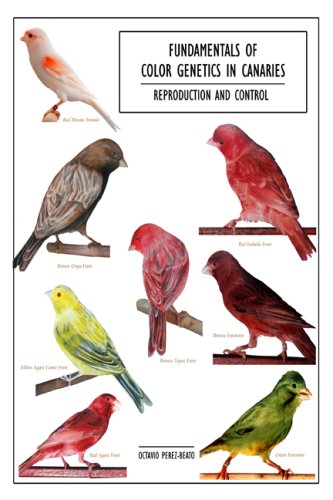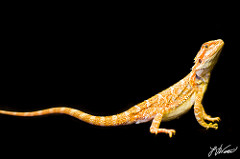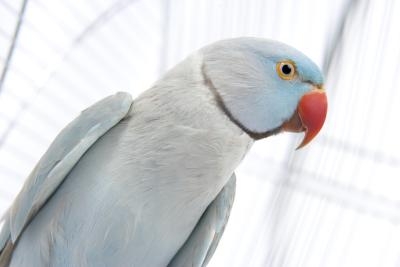Not a great deal was written about parrot-keeping in ancient times, and although in certain cases the information is repetitive, it is contradictory in others, so I have thought it best to give the quotations in full.
One thing that must be pointed out at once is that the Ancients knew of no difference between parrots and parakeets, so by them all psittacoses birds were simply classed together as "parrots".
From time immemorial any bird that could "talk" has charmed and mystified the human race, so it is not surprising to learn that in India, particularly among the Brahmins, "parrots" from the earliest times were not eaten but were held sacred simply because they could imitate the speech of human beings. This same facility fascinated the great ladies of ancient Rome, where talking "parrots" were highly prized luxuries, their price often exceeding that of a slave, and were frequently housed in magnificent cages made of ivory, tortoiseshell and silver.
The following interesting excerpt is from Dr. Russ's Die Fremdlandischen Stubenvogel, Parrot vol. Ill:
The old Egyptians did not know the parrots and in their hieroglyphics we find no sign or any indication of them. In like case were the Israelites, at any rate research shows that the name of Parrot is never once mentioned in the Bible. In the time of Alexander the Great they were introduced into Greece, for we are told, though there is some doubt about the correctness of this statement, that one of his retinue brought with him from India a species of parrot, which he found was commonly kept tame among the natives there.
This species, according to Wagler, was the Psittacus eupatrius of Linnaeus, now popularly known as the Large Alexandrine Parrakeet. As Aristotle (see Sundervall, Thierarten des Aristoteles (Stockholm 1863) and Lenz Zoologie der alten Grierhen und Romer (Gotha 1856)) gives such a very short description of the parrots, we may assume that he had but very rarely seen one, for otherwise such a painstaking author as he would have given a more satisfactory account.
It was the Ring-necked Parrakeet (P. torquata, Bodd) also commonly nowadays known as the Small Alexandrine, which the Romans knew, for this species was discovered in farthest Syria by Diodorus Siculus, a contemporary of Julius Caesar and Augustus and accurately described by Pliny, the first real description of a parrot we have. Martial tells us that they were kept in costly cages of silver, ebony and tortoiseshell, and were taught to speak human words, especially the name of Caesar. For their training special teachers were appointed and the price of a well-trained bird often exceeded that of a slave.
Turner, one of the earliest English writers on birds, gave in his Historia Avium, written in 1544, Pliny's interesting account as to the somewhat drastic, not to say brutal method of teaching parrots to speak in ancient Rome. The following quotation is taken from Turner on Birds by A. N. Evans, published about 1903:
Beyond all, Psittaci repeat men's words, and even talk connectedly. India sends this bird, which they call Psittace, with the whole body green marked only by a scarlet ring upon the nape. It will pronounce "Hail Emperor" and any words it hears; it is especially sportive after wine.
The hardness of the head is the same as of the beak, and when the bird is being taught to speak, it is beaten with an iron rod, else it feels not the strokes. When it flies down it receives its weight upon its beak, and supports itself thereon; and thus lightens itself to remedy the weakness of its feet.
As to the unfortunate bird having to stand on its head in order to remedy the weakness of its feet, Pliny seems to have thought this quite a normal procedure. For myself, however, I can only suppose that it was either suffering from concussion through having been hit on the head with an iron rod; or else, having been "especially sportive after wine", the poor thing had reached the stage where it was too drunk to stand up properly!
This is but a brief history of the keeping of parrots. Hopefully it has inspired the reader to try to glean more information himself on this fascinating subject.

 How to Setup Your Aviary and Manage Your Birds
Organizing your AviaryAt las
How to Setup Your Aviary and Manage Your Birds
Organizing your AviaryAt las
 A Guide to Colour Group Canaries
The Three Canary Groups - Co
A Guide to Colour Group Canaries
The Three Canary Groups - Co
 Military Macaws
Common Name:
Military Macaws
Common Name:
 Investigating Speedy Systems For Alligator
Alligators would be the most dangerous from the exotic pets
Investigating Speedy Systems For Alligator
Alligators would be the most dangerous from the exotic pets
 How Do I Know If My Bird Has Mites?
How Do I Know If My Bird Has Mites?
Ho
How Do I Know If My Bird Has Mites?
How Do I Know If My Bird Has Mites?
Ho